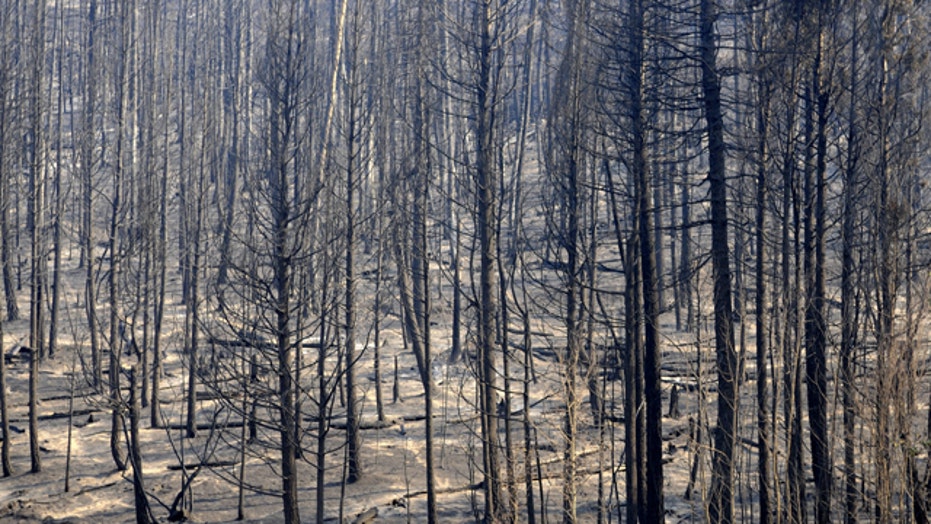SPRINGERVILLE, Ariz. – A raging forest fire in eastern Arizona that already forced thousands from their homes headed Wednesday for a pair of transmission lines that supply electricity to hundreds of thousands of people as far east as Texas.
The 607-square-mile blaze is expected to reach the power lines as early as Friday. If the lines are damaged, parts of New Mexico and Texas could face rolling blackouts.
Meanwhile, an Arizona sheriff ordered remaining residents of two towns in the path of the wildfire to evacuate by Wednesday evening. About 7,000 people live in Springerville and Eagar and surrounding areas, although many already have left.
The blaze has blackened about 389,000 acres and destroyed 11 buildings, primarily in the Apache-Sitgreaves National Forest. No serious injuries have been reported.
Firefighters have been concerned that high afternoon winds could carry embers that can cause new, smaller spot fires.
"We have a lot of people out there who are going to be doing nothing but looking for spots and putting those things out if they see them," fire spokesman Jim Whittington said.
Firefighters had spent the past two days trying to create a line where they could defend the towns. They used bulldozers to scrape off vegetation and hand crews to remove other fuels. The line hasn't been breached, but a spot fire did find an opening, Whittington said.
"It's not like the fire is in Springerville and Eagar," he said. "It's that potential for it to hook around the dozer line and (the) burnout we did and (then) move northeast into town" that prompted the evacuation.
By late Wednesday afternoon, the streets of Springerville were mostly empty. Apache County sheriff's deputies and other law enforcement officers could be seen going house-to-house as they looked for any remaining residents. Authorities were marking homes with yellow caution tape to signify that residents had left.
At Reed's Lodge along Springerville's Main Street, Daric Knight said he planned to stay to make sure no embers fell on the wood shingle roof or elsewhere on the property. Knight said his family has owned the lodge since the 1960s.
"I've seen lots of fires, but nothing like this," he said.
The fire prompted Texas-based El Paso Electric to issue warnings of possible power interruptions for its customers in southern New Mexico and West Texas.
The company uses two high voltage lines to bring electricity from the Palo Verde Nuclear Generating Station west of Phoenix to the two states. Losing the lines would cut off about 40 percent of the utility's supply, possibly triggering the rolling blackouts among its 372,000 customers.
Winds in the area were expected to gust up to 35 mph on Wednesday. Officials in Catron County, N.M., told residents of Luna to be prepared to leave if winds push the blaze into western New Mexico.
The blaze, burning in mainly ponderosa pine forest, was sparked May 29 by what authorities believe was an unattended campfire. It became the second-largest in Arizona history on Tuesday.
It has cast smoke as far east as Iowa and forced some planes to divert from Albuquerque, N.M., some 200 miles away.
Firefighters were also trying to protect the mountain towns of Alpine, Greer and Nutrioso. They were able to keep it out of the canyons surrounding the small resort town of Greer on Tuesday.
Thousands of firefighters, including many from several western states and as far away as New York, are already helping.
Dozens of them worked Tuesday alongside a stretch of U.S. 191 about two miles outside of Springerville, burning vegetation along one side of the highway to keep the approaching fire from jumping across and heading into town. Other crews removed brush from around homes near the foothills.
Angie Colwell, her husband Mike and their two children loaded up their belongings as authorities ordered their Eagar neighborhood to evacuate.
"We love the mountains and we're just afraid of what's going to be left after the fire comes through," Colwell said.
With a blaze as large as this being driven by unpredictable and gusty winds, putting the fire out is a gargantuan task. All fire managers can do is try to steer it away from homes and cabins by using natural terrain, burning out combustible material first and trying to put out spot fires sparked by embers blowing in front of the main fire front.
The cost of fighting the blaze has approached $8 million. Officials said it is likely to get more expensive.
Another major wildfire was burning in southeastern Arizona, threatening two communities. The 166-square-mile Horseshoe Two fire has devoured three summer cabins and four outbuildings since it started May 8.
Arizona's largest blaze came in 2002 when flames blackened more than 732 square miles and destroyed 491 homes west of the current fire. A fire in 2005 burned about 387 square miles in the Phoenix suburb of Cave Creek and consumed 11 homes.


